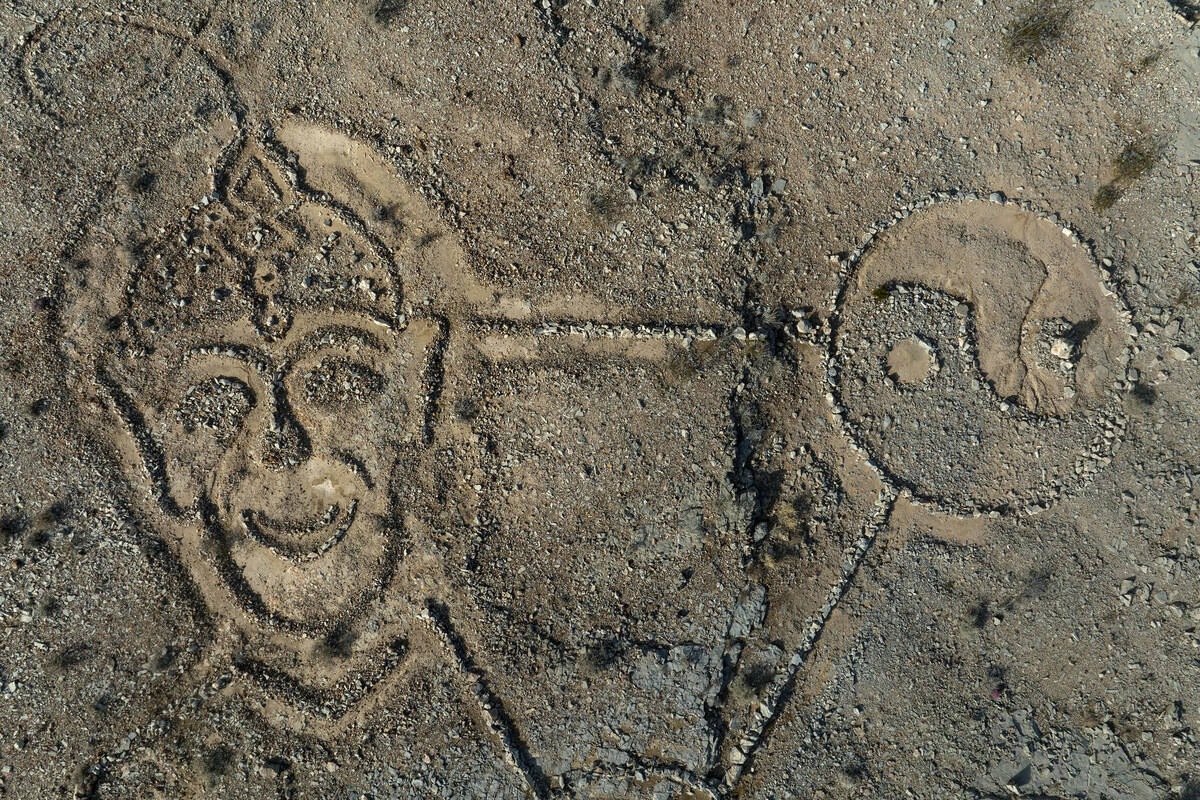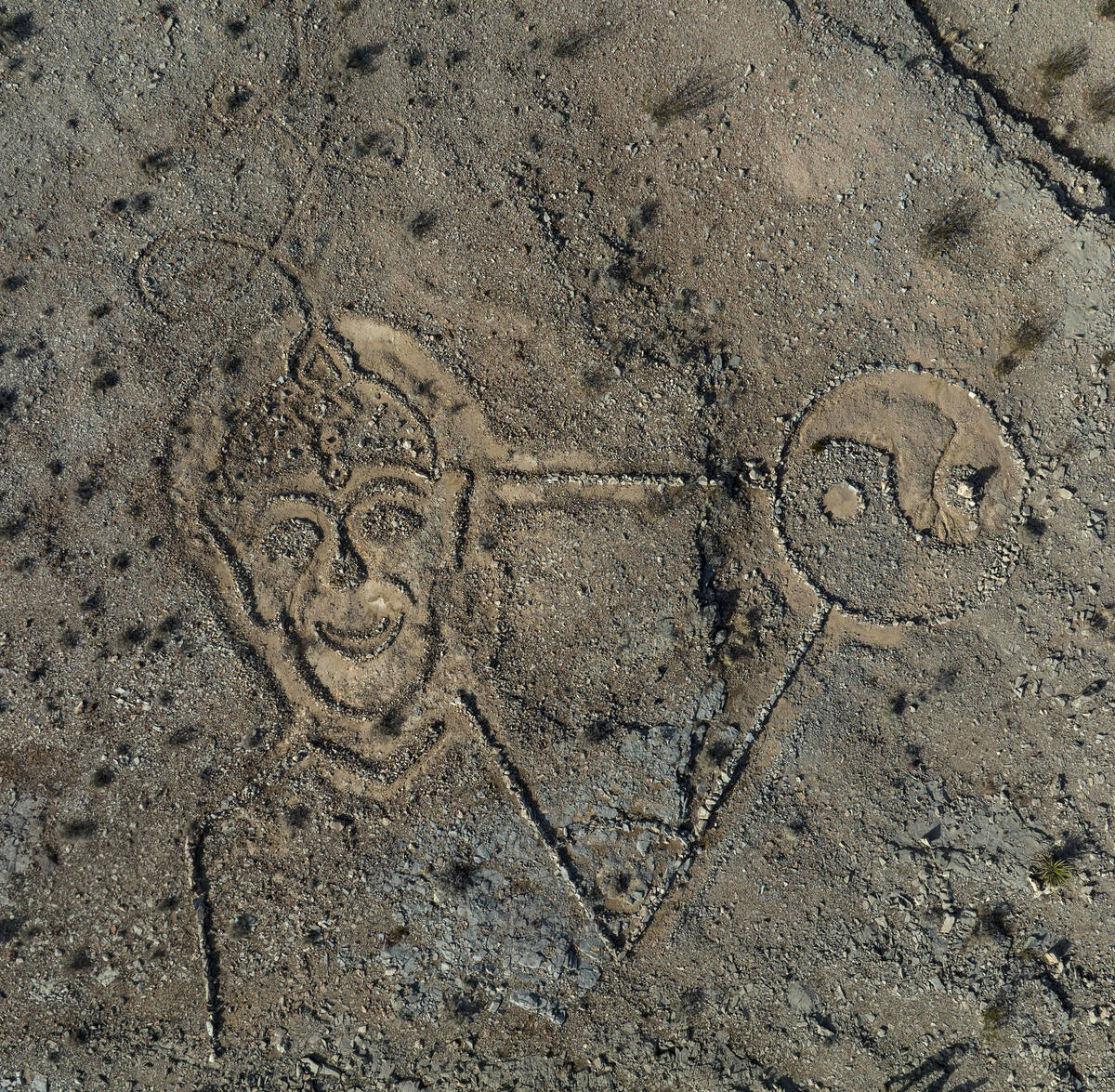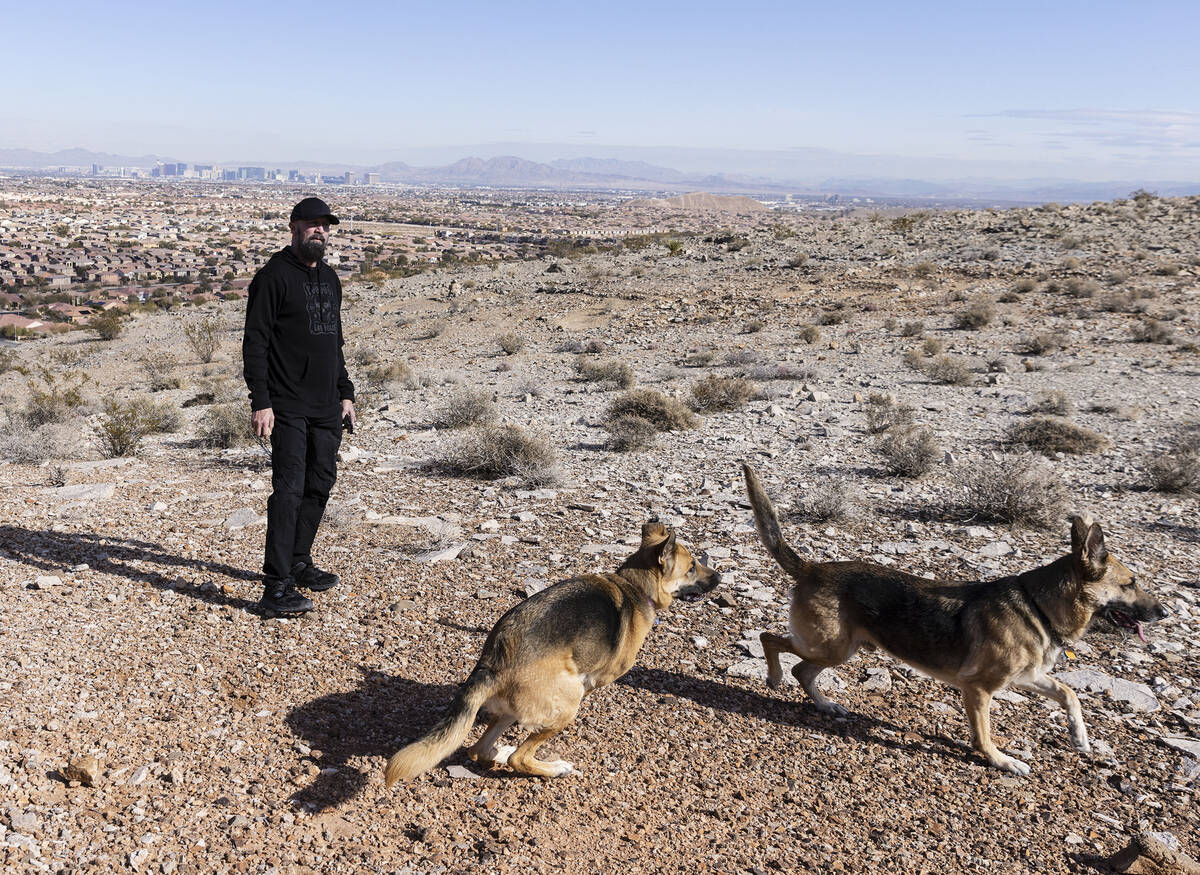Who made this mysterious artwork on a plateau overlooking Las Vegas?
Atop a rocky plateau overlooking Las Vegas lies a mysterious work of art.
Even when you’re standing right in front of it, you can’t see it. But if you pay close enough attention, you’ll notice that certain rocks — and they’re hard to see because it’s just a mess of rocks up there — have been arranged in a certain way on the plateau.
Only when you zoom out from high above, either with a drone or with Google Maps, do you see that it’s a large triangle with a face at one point and a yin and yang symbol at another point.
It’s not known who created the piece of land art or how long it’s been there. The Bureau of Land Management, which owns that land, found out about it when the Review-Journal asked for comment. BLM officials also don’t know who created it.
Hidden in plain sight
Dr. David Golan, who lives nearby, noticed it a couple of weeks ago while walking his dogs Jaxx and Sophie up the rocky hill, which stands just west of South Fort Apache Road and Cactus Avenue, where the Mountain’s Edge neighborhood in southwest Las Vegas ends and the desert begins.
Golan and his wife, Brandy Moore, found themselves on one of the formation’s higher ledges overlooking the hidden-in-plain-sight creation, and that’s when he noticed the way the rocks were forming shadows.
“I was at the very top up there looking down, and realized there was this just this pattern in the rocks, and I realized it’s a face and a yin and yang sign,” said Golan, 60, a former University Medical Center trauma physician who now operates clinics in Las Vegas.
After the 20-minute climb to the artwork on Thursday, Golan described what it looks like to the naked eye when you’re standing in front of it. Rocks piled up in some areas and cleared away in others, he said.
“You can’t see the image from the ground,” Golan said. “All you can kind of tell is that there are rocks piled up.”
‘Pretty miraculous artwork’
And the rocks are heavy, and jagged, so whoever undertook the work clearly must have spent a lot of time doing it. And each triangle side, including the face and symbol, are over 50 feet in length.
After initially noticing that something was there, Golan took photos and could kind of see a face in the photos. He then checked Google Maps, and that’s when the triangle with the face and symbol became well-defined and apparent. He also did a Google Images search, which allows users to see if any similar pictures exist online but couldn’t find anything anywhere that might give a hint to the artwork’s origin.
Golan, who said he’s been walking his dogs up the mountain regularly for five years and didn’t notice anything until a couple weeks ago, also posted photos of the artwork on Facebook.
Nobody seemed to know about it.
“I think someone did some pretty miraculous artwork up on the top of the hill, and I’m just surprised no one took any credit for it,” Golan said. “It’s kind of a beautiful piece of artwork and it’s just sitting here.”
Asked why someone would create the artwork, then not take any credit, Golan said, “That’s the mystery.”
Permits needed for land art
A BLM spokesperson said the bureau will investigate to determine what becomes of the artwork. Land art can be an important use of BLM lands but “permits are issued for land art such as this” to protect the environment from possible harmful disruption,” said Kirsten Cannon, the spokesperson for BLM’s Southern Nevada District.
“The key is working with BLM first so that analysis can be done to ensure damage to natural and cultural resources doesn’t happen in the creation of art,” she said. “Also, land art can increase visitation to an area, so proper site location and a permit are important.”
As a result of these concerns, Cannon said, an artist seeking to create or install a work of art on BLM lands would need to get a permit. One local example of permitted art on BLM land, Cannon said, is the Seven Magic Mountains sculpture in the desert south of Las Vegas near Jean.
“We have had other displays that have been placed without a permit in the past and if we knew who placed, them we worked with the individual(s) to remove them,” Cannon said in an email. “Since you told us about this, we will begin an investigation and determine the next steps.”
The piece could be considered a work of land art, also known as earth art, or art that is created and displayed in the natural environment, often from materials found in that environment. One of the more famous pieces of land art is Robert Smithson’s Spiral Jetty, a giant spiral made from over 6,000 tons of rock and earth that shoots out into Utah’s Great Salt Lake.
A prominent land art piece in Nevada is Michael Heizer’s City, a massive, mile-and-a-half-long sculpture described by the Review-Journal’s Jason Bracelin as “the geometry of the desert writ large.”
Golan said he hopes the art will be allowed to remain. The artwork consists solely of rearranged rocks, with no paint or artificial materials used, he noted. It also doesn’t seem dangerous because the rocks aren’t piled up in a way that they could collapse and injure or kill somebody.
“I can’t see how anyone would have a problem with this sculpture,” Golan said.
Contact Brett Clarkson at bclarkson@reviewjournal.com. Follow @BrettClarkson_ on Twitter.





















